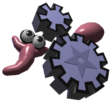Changeset 1232 for cpp/frams/genetics/f4/f4_oper.cpp
- Timestamp:
- 05/02/23 17:12:24 (2 years ago)
- File:
-
- 1 edited
-
cpp/frams/genetics/f4/f4_oper.cpp (modified) (2 diffs)
Legend:
- Unmodified
- Added
- Removed
-
cpp/frams/genetics/f4/f4_oper.cpp
r1231 r1232 16 16 // TODO the behavior of neuron input indexes during mutation seems badly implemented (see also TREAT_BAD_CONNECTIONS_AS_INVALID_GENO). Are they kept properly maintained when nodes are added and removed? This could be done well because during mutation we operate on the tree structure with cross-references between nodes (so they should not be affected by local changes in the tree), and then convert the tree back to string. Yet, the f4_Node.conn_from is an integer and these fields in nodes do not seem to be maintained on tree node adding/removal... change these integer offsets to references to node objects? But actually, do the offsets that constitute relative connection references concern the f4_Node tree structure (and all these sophisticated calculations of offsets during mutation are useful) or rather they concern the f4_Cells development? verify all situations in f4_Cell::oneStep(), case '['. 17 17 // TODO add simplifying sequences of modifiers (so capital and small letter cancel out, like in f1) - but seems like each single modifier is a separate f4_Node? and perhaps we don't want to use the repair mechanism for this... maybe mutations, when they add/modify/remove a modifier node, should be "cleaning" the tree by removing nodes when they encounter contradictory modifiers on the same subpath, and also limit the number of modifiers of each type just like in f1? To avoid sequences like ...<X>llmlIilImmimiimmimifmfl<fifmmimilimmmiimiliffmfliIfififlliflimfliffififmiffmfliflifmIlimimiflimfiffmllliflmimifllifliliflifmIlimimiflimfiffmllliflmimifllfmIlimimiflimfiffmllliflmimiflliflimimmiflimfliffmiflifmfiffllIlififliffififmiffmfliflifIliflimimflimflfflimimifllfflifllfflimlififfiiffifIr<r<... 18 // TODO in mutation, adding the '#' gene does not seem to be effective. The gene is added and genotypes are valid, but hardly ever #n is effective, i.e., it hardly ever multiplicates body or brain parts... investigate! 18 19 // TODO add support for properties of (any class of) neurons - not just sigmoid/force/intertia (':' syntax) for N 19 20 // TODO add mapping genotype character ranges for neural [connections] … … 123 124 f4_Node root; 124 125 int res = f4_process(geno, &root); 125 if (r es == 0 || root.childCount() != 1) return GENOPER_OK; // either parsing says the genotype is OK or the resulting tree will not be repairable (fatal flaw; root must have exactly one child) - do notattempt repair126 127 // here we have a genotype with r es>0 (for sure has some error) and root.childCount()==1 (still something was parsed into a tree)126 if (root.childCount() != 1) return GENOPER_OK; // the resulting tree will not be repairable (fatal flaw; root must have exactly one child) - do not even attempt repair 127 128 // here we have a genotype with root.childCount()==1 (meaning some part was successfully parsed into a tree) and either res==0 (syntax was correct, semantics we don't know) or res>0 (for sure has some error) 128 129 const int VALIDATE_TRIALS = 20; 129 130 res = ValidateRecur(&root, VALIDATE_TRIALS);
Note: See TracChangeset
for help on using the changeset viewer.
